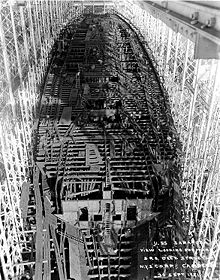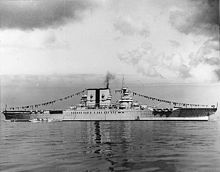- USS Saratoga (CV-3)
-
For other ships of the same name, see USS Saratoga.
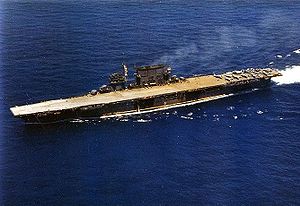
Career (United States) 
Ordered: 1917 (as battlecruiser)
1922 (as aircraft carrier)Builder: New York Shipbuilding Corporation Laid down: 25 September 1920 Launched: 7 April 1925 Commissioned: 16 November 1927 Reclassified: 1 July 1922 battlecruiser to CV Struck: 15 August 1946 Nickname: Sara Maru, Sister Sara, Stripe-Stacked Sara Honors and
awards:American Defense Service Medal ("Fleet" clasp)/American Campaign Medal / Asiatic-Pacific Campaign Medal (8 battle stars) / World War II Victory Medal Fate: Sunk by A-bomb test 25 July 1946 General characteristics Class and type: Lexington-class aircraft carrier Displacement: Design:
36,000 tons standard
38,746 tons; 53,000 long tons (54,000 t) (1945)Length: 850 feet (259 m) (waterline)
880 feet (268 m) (overall)Beam: 105 feet 5.25 inches (32.14 m) (waterline)
106 feet (32.31 m) (overall)Draft: 24.25 feet (7.39 m) (design) Propulsion: Design:
16 × boilers at 300 psi (2.1 MPa)
Geared turbines and electric drive
4 × shafts
180,000 shp (130 MW); 213,000 shp (159 MW) reached in serviceSpeed: 33.25 knots (61.6 km/h) (design); 34.99 knots reached in service[citation needed] Range: 10,000 nautical miles (19,000 km) at 10 knots (19 km/h) Complement: 2,122 officers and men Sensors and
processing systems:CXAM-1 RADAR[1] Armament: As built:
4 × twin 8-inch (200 mm) 55 caliber guns
12 × single 5-inch (130 mm) gunsArmor: Belt: 5 to 7 inches (130 to 180 mm)
2 inches (51 mm) protective 3rd deck
3 inches (76 mm) flat to 4.5 inches (110 mm) over steering gearAircraft carried: As built:
91 aircraft
2 × elevators
1 × flywheel catapultUSS Saratoga (CV-3) was the second aircraft carrier of the United States Navy and the fifth ship to bear her name. She was commissioned one month earlier than her sister and class leader, Lexington, which is the third actually commissioned after Langley and Saratoga. As Saratoga was visually identical to Lexington, her funnel was painted with a large black vertical stripe to assist pilots in recognizing her. This identifying mark earned her the nickname "Stripe-Stacked Sara." Saratoga, Enterprise, and Ranger were the only fleet aircraft carriers of the United States Navy built before the war to survive and serve throughout the U.S. involvement in World War II.
She was laid down on 25 September 1920, as Lexington class Battle Cruiser #3 by the New York Shipbuilding Corporation, at Camden, New Jersey; construction canceled and re-ordered as an aircraft carrier and reclassified CV-3 on 1 July 1922, in accordance with the Washington Naval Treaty limiting naval armaments; launched on 7 April 1925; sponsored by Mrs. Curtis D. Wilbur, wife of the Secretary of the Navy; and commissioned on 16 November 1927, Captain Harry E. Yarnell in command.
Contents
Service history
Inter-war period
Saratoga, the first fast carrier in the Navy, quickly proved the value of her type. She sailed from Philadelphia on 6 January 1928, for shakedown, and on 11 January, her air officer, the future World War II hero Marc A. Mitscher, landed the first aircraft on board. In an experiment on 27 January, the airship Los Angeles moored to Saratoga's stern and took on fuel and stores. The same day, Saratoga sailed for the Pacific via the Panama Canal. She was diverted briefly 14–16 February to carry Marines to Corinto, Nicaragua, and finally joined the Battle Fleet at San Pedro, California, on 21 February. The rest of the year was spent in training and final machinery shakedown.
On 15 January 1929, Saratoga sailed from San Diego with the Battle Fleet to participate in her first fleet exercise, Fleet Problem IX. In a daring move, Saratoga was detached from the fleet with only a single cruiser as escort to make a wide sweep to the south and "attack" the Panama Canal, which was defended by the Scouting Fleet and Saratoga's sister ship, Lexington. She successfully launched her strike on 26 January and, despite being "sunk" three times later in the day, proved the versatility of a carrier-based fast task force. The idea was incorporated into fleet doctrine and reused the following year in Fleet Problem X in the Caribbean. This time, however, Saratoga and Langley were "disabled" by a surprise attack from Lexington, showing how quickly air power could swing the balance in a naval action.
Following the fleet concentration in the Caribbean, Saratoga took part in the Presidential Review at Norfolk, Virginia, in May and returned to San Pedro on 21 June 1930.
During the remaining decade before World War II, Saratoga exercised in the San Diego – San Pedro area, except for the annual Fleet Problems and regular overhauls at the Bremerton Navy Yard. In the Fleet Problems, Saratoga continued to assist in the development of fast carrier tactics, and her importance was recognized by the fact that she was always a high priority target for the opposing forces. The Fleet Problem for 1932 was planned for Hawaii and, by coincidence, occurred during the peak of the furor following the "Manchurian incident", in which Japan started on the road to World War II. Saratoga exercised in the Hawaii area from 31 January to 19 March and returned to Hawaii for fleet exercises the following year from 23 January to 28 February 1933. On the return trip to the West Coast, she launched a successful air "attack" on the Long Beach area.
Exercises in 1934 took Saratoga to the Caribbean and the Atlantic for an extended period, from 9 April to 9 November, and were followed by equally extensive operations with the United States Fleet in the Pacific the following year. From 27 April to 6 June 1936, she participated in a Fleet Problem in the Panama Canal Zone, and she then returned with the fleet to Hawaii for exercises from 16 April to 28 May 1937. On 15 March 1938, Saratoga sailed from San Diego for Fleet Problem XIX, again conducted off Hawaii. During the second phase of the Problem, Saratoga launched a surprise air attack on Pearl Harbor from a point 100 miles (200 km) off Oahu, setting a pattern that the Japanese copied in December 1941. During the return to the west coast, Saratoga and Lexington followed this feat with "strikes" on Mare Island and Alameda. Saratoga was under overhaul during the 1939 fleet concentration, but from 2 April to 21 June 1940, she participated in Fleet Problem XXI, the last to be held due to the deepening world crisis.
World War II
1941
From 14 to 29 October 1940, Saratoga transported a draft of military personnel from San Pedro to Hawaii, and on 6 January 1941, she entered the Bremerton Navy Yard for a long deferred modernization, including the widening of her flight deck at her bow, the installation of a blister on her starboard side, and the installation of additional antiaircraft guns. The Saratoga was one of fourteen ships to receive the early RCA CXAM-1 radar.[1] Departing from Bremerton on 28 April 1941, the Saratoga participated in a landing force exercise in May and made two trips to Hawaii between June and October as the diplomatic crisis with Japan came to a head. On 26 November 1941, the Saratoga steamed towards Puget Sound and a shipyard overhaul there.
When the Japanese attacked Pearl Harbor on 7 December 1941, Saratoga was just entering San Diego Harbor after an interim drydocking at Bremerton, Washington. She hurriedly got under way the following day as the nucleus of a third carrier force (Lexington and Enterprise were already at sea), and Saratoga was carrying U.S. Marine Corps fighter planes that were meant to reinforce the Marine Corps garrison on Wake Island -- an American island in the Central Pacific. The presence of these Marine fighter planes on board Saratoga made her the logical choice to carry out and to defend the actual reinforcement effort.
[Note that the U.S. Marines on Wake Island repulsed the first attempted Japanese landing on their island, sinking two Japanese destroyers in the process.]
Saratoga reached Pearl Harbor on 15 December and she stopped only long enough to fuel up. She then rendezvoused with the Tangier, which had reinforcement troops and supplies on board, while the USS Lexington and the USS Enterprise provided distant cover for the operation. However, the task force of the USS Saratoga was delayed by the low speed of its accompanying oiler, and by then a decision to refuel its escorting destroyers on 21 December. After receiving reports of Imperial Japanese aircraft carrier warplanes over Wake Island, and then Japanese troops landing on it, this relief force was recalled on 22 December. Wake fell on the following day.
1942
Saratoga continued patrolling in the area of Hawaii, but on 11 January 1942, whiles she was heading towards a rendezvous with USS Enterprise about 500 nmi (580 mi; 930 km) southwest of Pearl Harbor, she was hit by a deep-running torpedo that had been fired by the Imperial Japanese submarine 8-inch (203 mm) guns[2]-- which were useless against attacking aircraft -- were removed for installation in shore batteries on Oahu. It was considered to be very unlikely that she would need these naval guns to defend herself from surface attack, and as a matter of fact, no large American aircraft carrier ever has experienced such an attack. In any case, American fleet carriers always had heavily-armed cruisers and oftentimes battleships to defend them against any surface attack. The enemies of the aircraft carrier were enemy warplanes and submarines.
Next, Saratoga steamed to the Bremerton Navy Yard in Washington State for permanent repairs to her hull in the large drydock there, repairs and overhaul to her machinery, and also the installation of a modern battery of antiaircraft guns. All of her original twelve 5"/25 caliber guns were replaced by sixteen 5"/38 caliber guns.[3]
Saratoga departed from Bremerton on 22 May, bound for San Diego Harbor. She arrived there on 25 May, and she had started retraining her carrier air group when the U.S. Navy codebreakers at Pearl Harbor deduced the Japanese Navy's plans for assault and amphibious landing on the American outpost on Midway Island.
Due to the need for Saratoga to take aboard new aircraft (including the new TBF Avenger torpedo bombers and repaired aircraft), hundreds of tons of food for her pantries, and spare parts for her aircraft, as well as the need for the Navy to gather together a task force of cruisers and destroyers to escort her, Saratoga was unable to steam out of San Diego until 1 June. She arrived at Pearl Harbor on June 6th, the final day of the Battle of Midway.
Saratoga departed from Pearl Harbor on 7 June after she was refueled, and reached the battle area early on the morning of 9 June. During the day Rear Admiral Frank Jack Fletcher (whose flagship Yorktown had been sunk during the battle) and his staff came aboard and made Saratoga his flagship. On 11 June, she transferred 34 of her carrier planes to Hornet and Enterprise to replenish their depleted air squadrons. Hornet had lost all of her torpedo bombers (Torpedo Squadron 8) in the Battle, and Enterprise had lost most of hers, too. So did USS Yorktown.
These three aircraft carriers steamed north from Hawaii to counter Japanese activity suspected in the Aleutian Islands of Alaska, but this attack did not materialize. Hence, Saratoga returned to Pearl Harbor on 13 June.
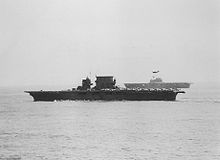 The Saratoga and the Enterprise off Guadalcanal in August 1942
The Saratoga and the Enterprise off Guadalcanal in August 1942
From 22 through 29 June, Saratoga carried more Marine Corps and U.S. Army Air Forces aircraft to Midway Island to replace the land-based planes shot down during the Battle of Midway.
Solomon Islands campaign
- July 1942—September
On 7 July, Saratoga steamed towards the Southwest Pacific Theater of Operations, and from 28 July through 30 July, she provided air cover for amphibious landing training in the Fiji Islands as part of the rehearsals for the planned invasion of Guadalcanal in the Solomon Islands. As the flagship of Rear Admiral Frank Jack Fletcher, Saratoga opened up the Guadalcanal campaign early on 7 August when she launched warplanes to attack Guadalcanal, Tulagi, and nearby islands. For the next two days, she also helped provide air cover for the amphibious landing of the 1st Marine Division on Guadalcanal and a smaller force on Tulagi.
On the first day of the assault, a Japanese air attack was repelled by fighter planes before it got close to the American fleet. However, since further air attacks were expected, the three carriers and their escort withdrew southwards on the afternoon of 8 August to make it to a refueling rendezvous with oilers. As a result, this task force was too far south to retaliate after four heavy cruisers and several destroyers were sunk that night in a naval surface action, the disastrous Battle of Savo Island, wherein the U.S. Navy found out the hard way the Imperial Japanese Navy had a excellent night warfare doctrine and that they were well practiced in it due to ample night live fire exercises.
The carrier task force departed to the east of the Solomon Islands, guarding the sea lanes to Guadalcanal expectantly alert for an Imperial Japanese Navy counterattack.
This counterattack, the third of five carrier versus carrier encounters during the war and now known as Battle of the Eastern Solomons began to materialize on 23 August, when a force of Japanese troop transports was detected. Saratoga and the other carries launched an air raid against the Japanese ships, but their aircraft were unable to find the enemy and, running low on fuel, they had to spend the night at Henderson Field on Guadalcanal. When these aircraft returned on the next day, the first contact report with an accurate location of enemy aircraft carriers was received from scouting forces sent out at dawn. Two hours later, Saratoga and her companions launched a strike that sank the Japanese light aircraft carrier Ryūjō.
Later on in the afternoon, when an air raid from two other Japanese aircraft carriers was detected, Saratoga quickly launched the warplanes on her flight deck, and these planes found and damaged the seaplane tender Chitose.
Meanwhile, due to covering clouds, Saratoga escaped detection by the Japanese. Their air strike concentrated on Enterprise and damaged her. The American aviators fought back valiantly, and enemy air strength was weakened so severely the Japanese Navy recalled its troop transports before they got close to Guadalcanal.
After recovering her returning planes in the evening of 24 August, Saratoga withdrew for refueling on the 25th, and then she resumed her sea patrols in the uncongested waters east of the lower Solomon Islands.
One week later, a U.S. Navy destroyer reported the bubbles of Japanese torpedo wakes heading towards the Saratoga, but the 888-foot (271 m)-long carrier could not turn quickly enough to evade the torpedoes. A moment later, a torpedo from the I-26 slammed into the underwater blister on her starboard side. The torpedo killed none of her sailors, and it flooded just one fireroom -- but its explosion caused multiple electical short circuits. These damaged Saratoga's turboelectric propulsion system, leaving her dead in the water. The cruiser Minneapolis took Saratoga in tow while she launched her aircraft off to reinforce shore airfields. By early afternoon, Saratoga's engineroom crew had improvised repairs to her electrical system from the burned wreckage of her main control board. She was then able to achieve 10 kn (12 mph; 19 km/h). [4]
After some temporary repair work at Tongatapu during 6 – 12 September, the Saratoga was able to steam northwards again, and she arrived at Pearl Harbor on 21 September for more solid repairs in a Pearl Harbor drydock. She returned to the Solomons area in November.
1943
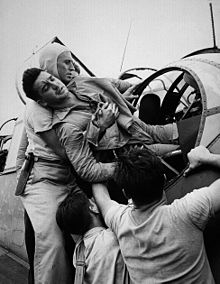 Saratoga crewmen tend to wounded TBF Avenger turret gunner after a raid on Rabaul 5 November 1943.[5]
Saratoga crewmen tend to wounded TBF Avenger turret gunner after a raid on Rabaul 5 November 1943.[5]
Saratoga sailed from Pearl Harbor on 10 November 1942, and proceeded via Fiji to the allied Naval base on Nouméa southeast of Guadalcanal, which she reached on 5 December 1942. She operated in the vicinity of Nouméa for the next twelve months, providing air cover for minor operations and protecting American forces in the Eastern Solomons should the Japanese send an invasion fleet covered by aircraft carriers.
From 17 May to 31 July 1943, she was reinforced by the British Illustrious class carrier Victorious, and on 20 October, she was joined by the Independence=class light aircraft carrier Princeton.
As troops stormed ashore on Bougainville Island on 1 November, Saratoga's aircraft neutralized nearby Japanese airfields on Buka Island. Then, on 5 November, in response to reports of Japanese cruisers concentrating at Rabaul to counterattack the Allied landing forces, Saratoga conducted perhaps her most brilliant strike of the war. Her aircraft penetrated the heavily defended port and attacked the shipping, disabling a number of the Japanese cruisers and ending the surface threat to Bougainville. Saratoga herself escaped unscathed and returned to raid Rabaul again on 11 November.
Saratoga and Princeton were then designated the Relief Carrier Group for the offensive in the Gilbert Islands, and after striking Nauru on 19 November, they rendezvoused on 23 November with the transports carrying garrison troops to Makin and Tarawa. The carriers provided air cover until the transports reached their destinations and then maintained air patrols over Tarawa. By this time, Saratoga had steamed over a year without repairs, and she was detached on 30 November to return to the United States. She underwent overhaul at San Francisco from 9 December 1943 to 3 January 1944, and had her antiaircraft battery augmented for the last time, receiving sixty 40 millimeter guns in place of thirty-six 20 millimeter guns.
1944
The carrier arrived at Pearl Harbor on 7 January, and after a brief period of training, sailed from Pearl Harbor on 19 January with Langley and Princeton, to support the drive in the Marshall Islands. Her aircraft struck Wotje and Taroa for three days, 29–31 January, and then pounded Engebi, the main island at Eniwetok, 3–6 February and again 10–12 February. Her planes delivered final blows to Japanese defenses on 16 February, the day before the landings, and provided close air support and CAP over the island until 28 February.
Saratoga then took leave of the main theaters of the Pacific war for almost a year to carry out important but less spectacular assignments elsewhere. Her first task was to help the British initiate their carrier offensive in the Far East. On 4 March, Saratoga departed Majuro with an escort of three destroyers, and sailed via Espiritu Santo; Hobart, Tasmania; and Fremantle, Australia, to join the British Eastern Fleet in the Indian Ocean. She rendezvoused at sea on 27 March with the British force, composed of Illustrious, Renown, Queen Elizabeth and Valiant with escorts, and arrived with them at Trincomalee, Ceylon, on 31 March. On 12 April, the French battleship Richelieu arrived, adding to the international flavor of the force, which also included warships from Australia, New Zealand, and the Netherlands. During the next two days, the carriers conducted intensive training at sea during which the aviators of Saratoga tried to impart some of their experience to the British pilots.
On 16 April, the British Eastern Fleet, with Saratoga in company, steamed out from Trincomalee, and on the 19th, aircraft from Illustrious and Saratoga struck the port city of Sabang (Operation Cockpit. The Japanese were caught by surprise by the new offensive and much damage was done to port facilities and oil reserves,[citation needed] with minimal losses. The raid was so successful Saratoga delayed her departure to carry out a second attack. Sailing again from Ceylon on 6 May, the task force struck at Surabaya, Java, on 17 May with equally successful results. Saratoga was detached the following day, and passed down the columns of the British Eastern Fleet as the Allied ships rendered honors to and from and cheered each other on .
Saratoga arrived at Bremerton, Washington, on 10 June 1944, for an overhaul. On 24 September, she returned to Pearl Harbor and commenced her second special assignment, training night fighter squadrons. Saratoga had experimented with night flying as early as 1931, and many carriers had been forced to land returning aircraft at night during the war, but only in August 1944 did a carrier, Independence, receive an air group specially equipped to operate at night. At the same time, Carrier Division 11, composed of Saratoga and Ranger, was commissioned at Pearl Harbor to train night pilots and develop night flying techniques and procedures. Saratoga continued this night training duty for nearly four months, but as early as October, her division commander was notified that "while employed primarily for training, Saratoga is of great value for combat and is to be kept potentially available for combat duty." The call came in January 1945. Light carriers like Independence had proven too small for most safe night flights, and Saratoga was rushed out of Pearl Harbor on 29 January 1945, to form a night fighter task group, along with Enterprise≤ for the invasion of Iwo Jima.
In September 1944, a Navy SBD dive bomber made the 75,000th landing on Saratoga. It was sixteen years earlier when Lieutenant Commander Marc Mitscher had made the first landing on Saratoga's flight deck.[6]
1945
Saratoga arrived at Ulithi on 7 February and sailed three days later with Enterprise and four other carrier task groups. After landing rehearsals with Marines at Tinian on 12 February, the carrier force carried out diversionary strikes on the Japanese home islands on the nights of 16 February and 17 February, before the landings on Iwo Jima. Saratoga was assigned to provide fighter cover while the remaining carriers launched the strikes on Japan, but in the process, her fighters raided two Japanese airfields. The force fueled on 18 and 19 February, and on 21 February, Saratoga was detached with an escort of three destroyers to join the amphibious forces and carry out night patrols over Iwo Jima and night heckler missions over nearby Chi-chi Jima. However, as she approached her operating area at 1700 on the 21st, an air attack developed. Taking advantage of low cloud cover and Saratoga's insufficient escort, six Japanese planes scored five bomb hits on the carrier in three minutes. Saratoga's flight deck forward was wrecked, her starboard side was holed twice and large fires were started in her hangar deck; she lost 123 of her crew dead or missing. An attack at 1900 scored an additional bomb hit. By 2015, the fires were under control, and Saratoga was able to recover aircraft, but she was ordered to Eniwetok and then to the West Coast for repairs, arriving at Bremerton on 16 March.
On 22 May, Saratoga departed Puget Sound fully repaired, and she resumed training pilots at Pearl Harbor on 3 June. She ceased training duty on 6 September after the Japanese surrender, and sailed from Hawaii on 9 September, transporting 3,712 returning naval veterans home to the United States as part of Operation Magic Carpet. By the end of her "Magic Carpet" service, Saratoga had brought home 29,204 Pacific war veterans, more than any other individual ship. At the time, she also held the record for the greatest number of aircraft landed on a carrier, with a lifetime total of 98,549 landings in 17 years.
Post-war
With the arrival of large numbers of Essex-class carriers, Saratoga was surplus to postwar requirements, and she was assigned to Operation Crossroads at Bikini Atoll to test the effect of the atomic bomb on naval vessels. She survived the first blast (Test Able), an air burst on 1 July, with only minor damage, but was damaged beyond repair by the second (Test Baker) on 25 July, an underwater blast which was detonated under LSM-60 500 yards (500 m) from the carrier. Salvage efforts were prevented by radioactivity, and seven and one-half hours after the blast, with her funnel collapsed across her deck, Saratoga slipped, stern first, beneath the surface of the lagoon. She was struck from the Naval Vessel Register on 15 August 1946.
Awards
Saratoga received seven battle stars for her World War II service.
Wreck
In recent years, the submerged wreck, the top of which is only 40 ft (12 m) below the surface, has become a scuba diving destination, one of only two carrier wrecks accessible to recreational divers. (The other is Oriskany, in the Gulf of Mexico.) The site was closed to divers in 2008 by the Kili/Bikini/Ejit Local Government Council. A combination of a failing global economy, high fuel prices, an unreliable airline and poor onsite management by the final divemaster ruined the profitability of the dive operation.Coordinates: 11°34′53.33″N 165°29′54.78″E / 11.5814806°N 165.49855°E
Saratoga in Popular Culture
The 1931 movie Hell Divers starred Wallace Beery and a young Clark Gable as a pair of competing pilots aboard Saratoga. The 1933 Joe E. Brown film comedy Son of a Sailor was also filmed aboard Saratoga and featured flight deck musters of the ships' company. Both films depicted actual carrier operations of F8C Helldiver aircraft.
In 1946, Jack Benny's radio show aired on board the ship as a farewell to her, four days before she was sunk.
See also
- List of aircraft carriers
- List of aircraft carriers of the United States Navy
- List of World War II ships
References
- ^ a b Macintyre, Donald, CAPT RN (September 1967). Shipborne Radar. United States Naval Institute Proceedings.
- ^ [1], DANFS entry for CV-3 Saratoga.
- ^ Friedman 1983 p. 51
- ^ Lundstrom, Guadalcanal Campaign, p. 171–172.
- ^ Crewmen lift AOM Kenneth Bratton, USNR, out of a TBF Avenger's rear turret after a raid on Rabaul 5 November 1943. The aircraft and a friendly F6F Hellcat successfully fought off eight attacking A6M Zeros, downing three. Bratton and pilot Commander Henry Caldwell survived. Photographer's Mate Paul Barnett was killed in action.
- ^ Naval Aviation News, 01 October 1944. "75,000th Landing on 'Sara'- Pilot Wins Cake in Celebration." p. 17.
- Friedman, Norman (1983). U.S. Aircraft Carriers. Naval Institute Press. ISBN 0-87021-739-9.
- This article includes text from the public domain Dictionary of American Naval Fighting Ships., Dictionary of American Naval Fighting Ships, Vol. VI, 1976, pp. 339-42.
External links
- USS Saratoga Association homepage
- General Plan for the U.S.S. Saratoga (CV-3), hosted by the Historical Naval Ships Association (HNSA) Digital Collections
- Navy photographs of Saratoga (CV-3)
- Saratoga under construction as a battlecruiser
- Image from the launching of the U.S.S. Saratoga
- "How Swift Navy Planes Hit the Spot On Carriers Deck", December 1931, Popular Science large 1931 on aircraft operation on CV-3
- Scuba diving to the U.S.S. Saratoga
(converted from battlecruisers in accordance with the Washington Treaty)
Lexington · SaratogaLexington-class battlecruisers (scrapped in accordance with the Washington Treaty)
Constellation · Ranger · Constitution · United StatesPreceded by: USS Langley - Followed by: USS Ranger
List of aircraft carriers of the United States Navy Categories:- Lexington class battlecruisers
- World War I battlecruisers of the United States
- Lexington class aircraft carriers
- Ships built in New Jersey
- 1925 ships
- World War II aircraft carriers of the United States
- Ships damaged by aircraft
- Ships sunk as targets
- Shipwrecks in the Pacific Ocean
- Bikini Atoll
Wikimedia Foundation. 2010.

